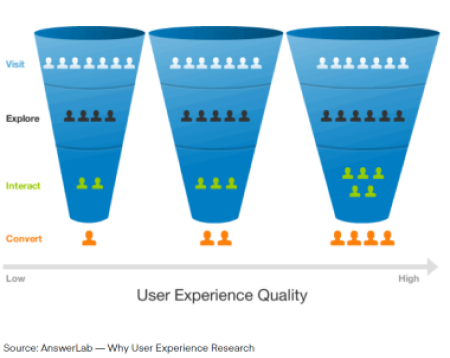Developing and deploying a mobile app is just one part of the mobile app development journey. Considering that mobile accounts for 70% of watch time and 92% of people spend time on mobile apps, it is becoming extremely vital for companies to optimize the app to keep its users interested all the time.
Data is used by app markers to un-reveal strategies to simplify and streamline the customer funnel & enhance app performance. Mobile app analytics play a vital role here because it aids in improving customer engagement and retention rate. That's why nearly one-third of marketing people boost their expenditure on data analytics.
In this article, we will explain different mobile app terminologies and explain why it is important for app marketers to keep an eye on different tracking data to reach their business goals.

What is mobile app analytics?
The phrase "mobile app analytics" refers to the collection and analysis of the data acquired from the multiple activities of the user on the app. The aim after collecting data is to transform that data into knowledge and analysis.

The information gained through mobile app analytics can help to clarify how your users interact with your application, how effectively it runs, and detect typical issues with the application's user experience. As a consequence, you'll be in a good perspective to make educated app-improvement decisions that will enhance engagement, reduce app attrition, conversions, & installs.

Mobile analytics collects information of visitors to mobile apps, websites, and web apps. All this to determine different users, follow their itineraries, track their activity, & evaluate for app's success. There are about 6.5 million applications in the main mobile application store, millions of online apps, and over a billion sites. Companies employ mobile app analytics tools to compete effectively in creating unique mobile experiences.
Organizations use this data to determine what their customers desire to provide a more satisfying UX. They can, for instance, find:
-
What entices users to visit the mobile app?
-
How long do most visitors stay?
-
Where do they run into problems?
-
What elements contribute to increased usage and long-term retention?
-
What elements do they interact with? What factors are associated with events such as purchase decisions?

It's no surprise that app analytics are important to mobile app development. The cause for this is that without having data on app usage patterns (Behavioral data) and app performance, companies cannot provide customers with an ideal experience. The app marketing strategies might suffer as a result!
The following are some of the most relevant front-end metrics:
App breakdown reports- These reports contain information such as the application versions, device information, operating system, and the action made at the moment of the incident. This is useful when attempting to recreate an issue throughout the QA testing.
UI, app response, and render time report- This data reveals whether or not the program is functioning quickly and smoothly.
Visitor pathways report- This data provides insight into how users interact with the application (and how the app's UI/UX may be developed to make the app more user-friendly and enhance conversions).
Daily active users report- This data tells you if your user base is expanding, contracting, or remaining steady. It is significantly extra crucial than overall downloads because many consumers download and then uninstall or overlook the app.
OS/device comparability report- This information gives critical details into the Quality assurance process. This might be beneficial to seek compatibility with a wider range of devices and operating systems (OS).
The following are some of the most relevant back-end metrics:
Server response duration- Server response time data can help you determine whether you're assigning enough server resources to your application. For instance, in a requirement for your program to be authorized into the App Store, Apple demands a 500-millisecond upload speed.
Time to first-byte report- This information is critical for determining the efficiency and responsiveness of your server. It is the amount of time that elapses between when a client initiates an HTTP request and when the consumer gets the first byte of data in answer to that query. The TTFB of a "slow" app would be high.
HTTP request frequency data- This data shows the volume and frequency of HTTP queries. When the app seeks data from the server, each HTTP call represents an instance. This results in increased data consumption and a lengthier load time.
TCP Connection Duration- When using SSL, the TCP connection duration shows how long it takes to communicate with the server. A long TCP communication time frame will result in a slow response and a bad user experience.
5 Best Practices - Mobile App Analytics
1. Retention Rates:
Your Retention Rate is a critical app measure for understanding the utility of your app. Maybe not each of your customers may proactively use your application, they may nonetheless contact you in an emergency.
This is what your application Retention Rate is – the number of visitors who return to your application (after downloading and installing it) at a minimum once within a set timeframe. Many marketing leaders prefer to focus on retention rather than acquisition (provided the latter figures are reasonable, of course), because retention initiatives do not incur any costs, as opposed to the marketing and sales expenses involved with acquiring efforts & costs.
You should preferably assess your retention rates monthly, quarterly, or annually, and the greatest thing is that you can do so online.
Build An Engaging App For Free
Because organizations spend money on sales and marketing to attract new customers, that's the main reason why app retention is crucial to app success. The firm loses revenue if newcomers leave. Having a high retention rate is nearly always a positive thing. Monitoring retention will indeed alert you if your application's current version has lost steam.
2. In-app Analytics
In-app analytics includes information such as device kind, operating system, geography, languages, gender, age, new or old customer, pages seen, adverts clicked, purchases made, and so on. Working with this data will undoubtedly enhance the customer experience.
A typical user's path via an application is as follows: launching the application, browsing through various items or product pages, checking customer reviews, adding the item to the cart, evaluating, and finally ordering it. The purchasing price is determined by several things. What can be done in this case is to comprehend the experience that drives their purchase, and with what they engage in the app. We can optimize the functionalities and conversation pathways by studying this data.

For example, suppose a lot of users are chasing and visiting the second session page of the application, rendering it one of the most visited/clicked. To make it easy for them, we may move that experience or item to the landing page itself – this would not only spare the time but will also ensure user happiness, leading to an increase in purchase volume.
In-app events enable us to identify the most popular features among users and make income from in-app sales.
3. DAU (Daily Active User)
The number of daily sessions per DAU indicates how often your visitors/ customers log into your application every day. More sessions are occasionally preferable, like with a social media app, but this is not necessarily the case. Users may be logging in frequently out of annoyance or because of a mistake. To get the whole picture, combine this statistic with others such as user satisfaction and behavior flow.
4. Performance Analytics
We understand how frustrating it is if you're doing something essential on the application and the app fails just when you're about to accomplish the activity. On occasions, there is no turning back, and app crashes can cause 71% of users to remove the application. Another thing that may assist here is when a customer reports a fault or a bug and the problem is resolved immediately. According to reports, iOS devices account for 67 percent of all reported issues. But if the users don't find meaning in it, 29% will uninstall the app. According to a poll, 65 percent of consumers believe that a poor mobile application has a negative influence on the company.

To summarize, the condition of your app is critical for providing the optimal user experience.
Performance analytics data helps you to identify the app faults, maximize your improving time, and eventually lead to the application's success.
5. ARPU (Average Revenue Per User)
If you appear to be making huge revenue, it's an excellent idea to examine how much you're gaining per user. Thousands of US$ each month may appear great at first, but not when based on millions of users. ARPU can assist you in determining when you might be generating more income per user.
Apps with both paid & unpaid users can calculate their average income per paying customer to get a better understanding of what every paying customer is worth.
What Is the Importance of App Metrics?
You'll be prepared for future upgrades and UI/UX enhancements if you have customer behavior data and insight into how your application is functioning. Timely app maintenance is a critical component of UI/UX quality standards. Nonetheless, you must analyze these sets of data following app upgrades and changes.
Don't be shocked if you find surprising results, especially in the beginning when you're still getting to know your potential audience. You could only make informed predictions while designing an app or executing upgrades. This might lead to discrepancies between that and what you anticipate and what happens.

The metrics listed above enable you to:
-
Determine opportunities to improve app performance, responsiveness, and general UX.
-
Evaluate how users are connecting with the interface.
-
Assess the app's design's effectiveness.
-
Determine user behaviors and preferences.
-
Incorporate optimizations and structural changes to ensure that the UI corresponds to how users use the app's features and functionalities.
According to Statistica, a user spends about 5-6 minutes every session on an app. To guarantee that the user returns to the application, it is critical to provide the greatest possible experience within this limited time. Optimizing the user experience necessitates an awareness of the user's touchpoints as well as what keeps them coming back. So, what's the secret to grasping these concepts? All that we have mentioned above. You'll be able to enhance your in-app experience and generate additional utility for your users and yourself by gathering and examining data points.

Mobile app analytics is unquestionably an important component of any mobile app marketing approach. Furthermore, adhering to mobile app analytics guiding principles helps guarantee that you make the maximum of the data you collect. Meanwhile, take into consideration that this method requires time and patience, so don't hope to see results right away.




